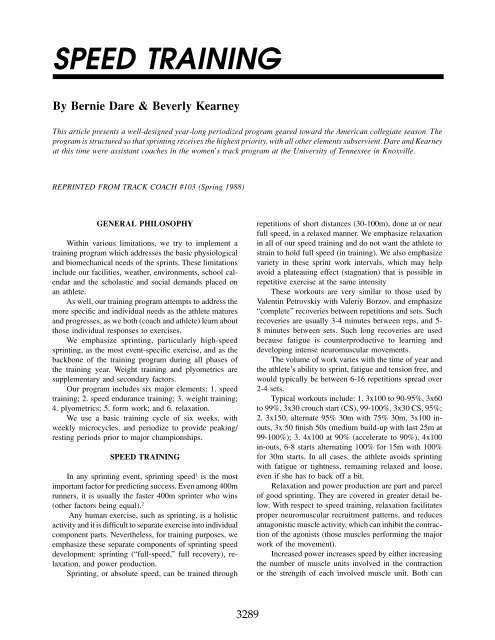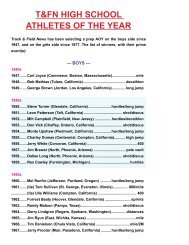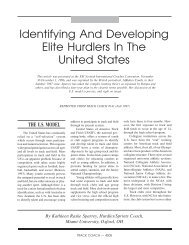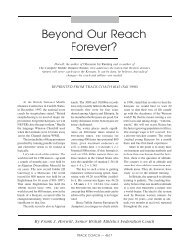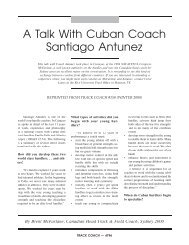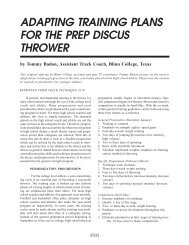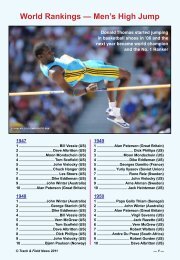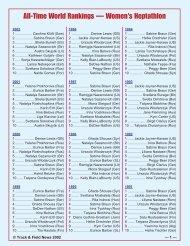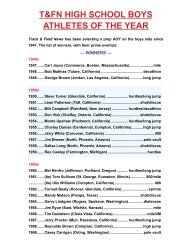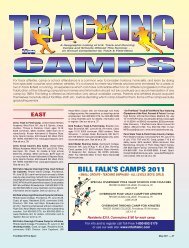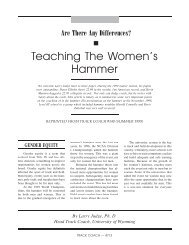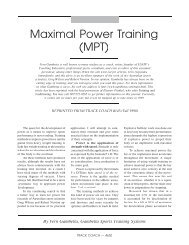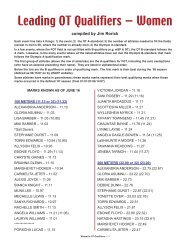SPEED TRAINING - Track & Field News
SPEED TRAINING - Track & Field News
SPEED TRAINING - Track & Field News
You also want an ePaper? Increase the reach of your titles
YUMPU automatically turns print PDFs into web optimized ePapers that Google loves.
<strong>SPEED</strong> <strong>TRAINING</strong><br />
By Bernie Dare & Beverly Kearney<br />
This article presents a well-designed year-long periodized program geared toward the American collegiate season. The<br />
program is structured so that sprinting receives the highest priority, with all other elements subservient. Dare and Kearney<br />
at this time were assistant coaches in the women’s track program at the University of Tennessee in Knoxville.<br />
REPRINTED FROM TRACK COACH #103 (Spring 1988)<br />
GENERAL PHILOSOPHY<br />
Within various limitations, we try to implement a<br />
training program which addresses the basic physiological<br />
and biomechanical needs of the sprints. These limitations<br />
include our facilities, weather, environments, school calendar<br />
and the scholastic and social demands placed on<br />
an athlete.<br />
As well, our training program attempts to address the<br />
more specific and individual needs as the athlete matures<br />
and progresses, as we both (coach and athlete) learn about<br />
those individual responses to exercises.<br />
We emphasize sprinting, particularly high-speed<br />
sprinting, as the most event-specific exercise, and as the<br />
backbone of the training program during all phases of<br />
the training year. Weight training and plyometrics are<br />
supplementary and secondary factors.<br />
Our program includes six major elements: 1. speed<br />
training; 2. speed endurance training; 3. weight training;<br />
4. plyometrics; 5. form work; and 6. relaxation.<br />
We use a basic training cycle of six weeks, with<br />
weekly microcycles, and periodize to provide peaking/<br />
resting periods prior to major championships.<br />
<strong>SPEED</strong> <strong>TRAINING</strong><br />
In any sprinting event, sprinting speed 1 is the most<br />
important factor for predicting success. Even among 400m<br />
runners, it is usually the faster 400m sprinter who wins<br />
(other factors being equal). 2<br />
Any human exercise, such as sprinting, is a holistic<br />
activity and it is difficult to separate exercise into individual<br />
component parts. Nevertheless, for training purposes, we<br />
emphasize these separate components of sprinting speed<br />
development: sprinting (“full-speed,” full recovery), relaxation,<br />
and power production.<br />
Sprinting, or absolute speed, can be trained through<br />
repetitions of short distances (30-100m), done at or near<br />
full speed, in a relaxed manner. We emphasize relaxation<br />
in all of our speed training and do not want the athlete to<br />
strain to hold full speed (in training). We also emphasize<br />
variety in these sprint work intervals, which may help<br />
avoid a plateauing effect (stagnation) that is possible in<br />
repetitive exercise at the same intensity<br />
These workouts are very similar to those used by<br />
Valentin Petrovskiy with Valeriy Borzov, and emphasize<br />
“complete” recoveries between repetitions and sets. Such<br />
recoveries are usually 3-4 minutes between reps, and 5-<br />
8 minutes between sets. Such long recoveries are used<br />
because fatigue is counterproductive to learning and<br />
developing intense neuromuscular movements.<br />
The volume of work varies with the time of year and<br />
the athlete’s ability to sprint, fatigue and tension free, and<br />
would typically be between 6-16 repetitions spread over<br />
2-4 sets.<br />
Typical workouts include: 1. 3x100 to 90-95%, 3x60<br />
to 99%, 3x30 crouch start (CS), 99-100%, 3x30 CS, 95%;<br />
2. 3x150, alternate 95% 30m with 75% 30m, 3x100 inouts,<br />
3x 50 finish 50s (medium build-up with last 25m at<br />
99-100%); 3. 4x100 at 90% (accelerate to 90%), 4x100<br />
in-outs, 6-8 starts alternating 100% for 15m with 100%<br />
for 30m starts. In all cases, the athlete avoids sprinting<br />
with fatigue or tightness, remaining relaxed and loose,<br />
even if she has to back off a bit.<br />
Relaxation and power production are part and parcel<br />
of good sprinting. They are covered in greater detail below.<br />
With respect to speed training, relaxation facilitates<br />
proper neuromuscular recruitment patterns, and reduces<br />
antagonistic muscle activity, which can inhibit the contraction<br />
of the agonists (those muscles performing the major<br />
work of the movement).<br />
Increased power increases speed by either increasing<br />
the number of muscle units involved in the contraction<br />
or the strength of each involved muscle unit. Both can<br />
3289
esult in increase of force against the ground, which can<br />
produce a longer stride or, more importantly, if more force<br />
can be created in less time, less ground contact time and<br />
greater stride frequency. (It is less ground contact time,<br />
and therefore greater stride frequency, which separates<br />
good and great sprinters 4 ).<br />
<strong>SPEED</strong> ENDURANCE <strong>TRAINING</strong><br />
Speed endurance—the ability to maintain high speed<br />
sprinting—has two metabolic facets: alactic speed endurance<br />
and lactic (glycolytic) speed endurance.<br />
These metabolic processes are not absolutely separable,<br />
and training the lactic system certainly trains the<br />
alactic system. The alactic system, or short speed endurance,<br />
predominates in exercise through the 200m. The<br />
lactic system, or long speed endurance, begins contributing<br />
to intense exercise after about 5 seconds, however, and<br />
probably becomes the dominant system between 10-20<br />
seconds of activity. 5<br />
Due to various reasons, we separate in training the<br />
groups of sprinters who are better at the 100-200m (the<br />
“short sprints”) from the 200-400m runners (the “long<br />
sprints”). This is due not only to the different energy<br />
demands between the two types of sprints, but also to<br />
reduce anxiety among short sprinters who dread training<br />
distances beyond 300m in length.<br />
Although these workouts vary with the cycle being<br />
used at the moment, short sprinters do repetitions of 100-<br />
300m, with volumes of 2-10, depending on the length of<br />
the work interval and its intensity (speed). 6 Long sprinters<br />
do repetitions of 150-600m, with volumes of 2-12, with<br />
the same considerations as the short sprinters.<br />
We categorize all of our speed endurance work as<br />
“interval” work, as there is a work interval (sprint) and<br />
recovery interval (rest) involved, rather than use the many<br />
other names (repetitions, extensive, intensive, etc.).<br />
Then, we categorize our interval work by the intensity<br />
(speed), duration (time or distance), and degree of<br />
total fatigue created by each work interval and the total<br />
workout. The volume of the workout is then determined<br />
by the contribution of each interval to the total fatigue of<br />
the lactic acid or alactic energy system.<br />
The workouts tend to fall into three categories, with<br />
some overlap:<br />
1. Low Anaerobic Stress Workouts, characterized by<br />
low to medium intensity, short to medium durations, low<br />
to medium stress or fatigue—they approach total fatigue<br />
slowly.<br />
These sprint workouts build up fatigue slowly, and are<br />
used with short recoveries between sprints (1-3 minutes,<br />
or 120 bpm heart rate). They are primarily used in the<br />
early cycles (prior to Christmas break), and may also be<br />
used for aerobic conditioning.<br />
Examples: 3-4x150, 3-4x100, 3-4x50 to 90% with<br />
1-2 min between reps, 2-4 min between sets; 8x200 with<br />
100 walk, 100 jog as rest (1-2 min) at about 28-30 sec<br />
each; 10x150 accelerations to 90%, 1-2 mm rest; 5-6x<br />
300 with 1-2 min rest, slow (48-54) 5x200 with 3 min<br />
rest, moderate (27-28); 6-12x400 fartlek (100 walk, 100<br />
jog, 100 stride—65-70 pace, 100 sprint—90%); 3-4x300-<br />
200 1 min between 300 and 200, 3-5 min between sets,<br />
approx. 48-50 and 27-29.<br />
2. Medium to High Anaerobic Stress Workouts, characterized<br />
by medium to high intensity, short to long durations,<br />
medium to high stress or fatigue—they approach<br />
total fatigue more quickly, each interval significantly<br />
contributing to total fatigue.<br />
These sprints are run at or near event race speeds, they<br />
build up fatigue quickly. Relatively complete recoveries<br />
(to 100 bpm HR) are used, as each interval contributes<br />
significantly to total fatigue. The recoveries may be long<br />
(10-30 minutes), or progressive (5-8 min, 8-12 min, 12-15<br />
min—longer with each proceeding work interval). Complete<br />
recoveries are used when doing these workouts near<br />
championship meets (in peaking/resting phases).<br />
Examples: 3-4x300 (5-8 min rest 39-44, depending<br />
on ability); 1x600, 1x500, 20-30 min rest, very fast (1:<br />
30-1:38; 72-75); 500-300-200, progressive rests (72-75;<br />
5-8 min; 39-42; 8-12 min; 24-25) or 500-300-200, progressive<br />
rests (72-75; 5-8 min; 39-42; 8-12 min; 24.25)<br />
or 500-300-200 with 5 min rests (76-80, 40-44, 25-27);<br />
3x200 at 99% with 10 min rests; 1x300, 10-20 min rest,<br />
1x200 at 99%; 300-300-200-200 with 5 min rests (40-43;<br />
25-27).<br />
3. High Anaerobic Stress Workouts, characterized<br />
by high intensity, medium to long durations, high to<br />
very high stress or fatigue—approach total fatigue very<br />
quickly—exhaustive workouts. These are very hard workouts<br />
and are not done in, or too near, a peaking phase<br />
(1 1 / 2-2 weeks before Conference Championship). They are<br />
meant to simulate 400m race stresses, and are not done<br />
more often then once a week (usually once every two<br />
weeks).<br />
Examples: 300-200 at race pace for 400 with 1 min<br />
rest, 20 min rest, repeat or 200-200; 1x500 at 99%, 20-<br />
30 min rest, 1x300 at 99%; 1x600 at 99-100%, go home;<br />
lx500 at 99-100%, go home. For the short sprinter—1 x200<br />
at 99%, 3x100 at 99%, 3x50 at 99% all with 5 minutes<br />
rest.<br />
In training speed endurance, we start with type 1<br />
workouts and blend in to type 2 workouts, done below<br />
(slower than) the ability of the athlete, in our cycles before<br />
Christmas break. After Christmas, we begin with type 2<br />
workouts, then add type 3 workouts when the athletes<br />
are ready for them. As we near championship meets, we<br />
eliminate the type 3 workouts and modulate the type 2<br />
workouts (more rest, more speed). We do the harder workouts<br />
near the beginning of the week. We treat meets as<br />
hard workouts and have an easy or rest day after them.<br />
3290
WEIGHT <strong>TRAINING</strong><br />
Weight training has two major rationales. One is<br />
to provide total body conditioning to prevent muscle<br />
imbalances, and to provide general muscle-tendon-ligament<br />
strengthening to reduce injury and better perform<br />
workouts. The second is to increase muscle group strength,<br />
through either increased recruitment of muscle fibers or<br />
strengthening of muscle fibers (both occur), to increase<br />
the ability to apply power to the ground.<br />
Current training theory for weight lifting usually has<br />
the athlete begin with 8-12 repetitions of an exercise,<br />
proceeding to sets of 6 or less (at appropriate repetition<br />
maximums—RMs), as fast-twitch muscle fibers are not<br />
significantly trained above 6 RM. Variety, or set-rep<br />
changes are used throughout the year to avoid stagnation.<br />
7 Maintenance work (3-4 sets of 5 reps, 1-2 week)<br />
should be done in the peaking/resting cycles.<br />
Excluding warm-up sets, set-reps structure could be:<br />
4-6 weeks general conditioning—3-4 sets of 8-10 reps;<br />
normal six week cycles—4-5 sets of 5 reps, or 5-5-3-3-<br />
(3), or 5-5-3-2-3; peaking/resting cycles—3 sets of 5 reps<br />
1-2 x week as able-in all other cycles lift 3 x week or 5<br />
x over a two-week period.<br />
Current program: Weeks 1-4 (Cycle I): 4 sets of 10<br />
reps. Weeks 5-9 (Cycle II): sets of 10-5-5-3-3-3. Week<br />
10 (end of Cycle II): Max in key lifts. Christmas break:<br />
as able. This series is then repeated during the six-week<br />
cycles (Cycles Ill and V), with a maintenance program<br />
during the peaking/resting cycles (IV, VI). Weight lifted<br />
per exercise is expected to be progressive throughout the 5<br />
weeks of 10-5-5-3-3-3, then maxed for 1 week, then going<br />
to a reduced resting phase (peaking/resting cycles).<br />
The current lifts are: squats (parallel), bench press,<br />
arm curls, tricep curl (french press), incline press, leg<br />
press (machine), calf rise, hamstring curl (machine), leg<br />
extension (machine), and lunges.<br />
PLYOMETRICS<br />
Done correctly, plyometric exercises are very intense,<br />
and their major rationale is to increase the ability to apply<br />
force to the ground very quickly. Since great sprinters are<br />
able to apply large force to the ground from small knee<br />
angles (less knee bend and less leg flexion throughout<br />
the force application) with short ground contact times,<br />
plyometric activities should mimic such actions. They<br />
should be very fast with short ground contact times, and<br />
should use shallow knee flexion. 8<br />
Our current major plyometric activity was to be flying<br />
start, single-leg hops (20m sprint start, 30m hopping).<br />
However, the skill level of our athletes in performing this<br />
activity was not high enough, and a learning process is<br />
now occurring.<br />
Instead, we are going more general plyometric work,<br />
including bounding, skipping, and hopping without a flying<br />
start (200-600m of varied activity). We do these once a<br />
week and intend to do them twice a week (1 x week fast<br />
plyometric activity, 1 x week general plyometric activity)<br />
when skill levels are increased (we wish to avoid injuries<br />
caused by the unskilled doing an explosive activity).<br />
FORM WORK<br />
Form work, or isolating and training various facets<br />
of sprinting form, has been a part of much sprint training.<br />
However, there are some questions as to its efficacy.<br />
Recent biomechanical analysis of arm motion, for<br />
example, has failed to find any great significance in the<br />
specifics of arm motion to sprinting ability. Earlier studies<br />
also point out that neuromuscular coordination is very<br />
specific to the speed of movement. That is, form work has<br />
to be done at event speeds to properly stimulate and train<br />
the event neuromuscular coordination (firing sequence of<br />
the muscles). Form work does have a purpose. Its uses<br />
are: 1. as a warm-up acitivty; 2. to develop a feeling for<br />
muscle movements that can be transferred to high speed<br />
activity, and, 3. to strengthen certain muscle groups.<br />
Under purpose 1, the slower, rhythmical form of<br />
sprinting loosens, stretches, and warms up the muscles for<br />
sprinting. Under 2, it can train the athlete to recognize what<br />
muscle groups are doing, and should do, during sprinting<br />
(of varying importance: the relaxed and quick recovery<br />
of the foot and leg after ground contact, creating a short,<br />
level movement efficiently; allowing knee lift to occur,<br />
as it will, without forcing it or preempting it, to drive or<br />
stab the foot quickly to and off the ground after knee lift<br />
has occurred). Under 3, the hamstrings, hip flexors and<br />
extensors, and ankle flexors can be strengthened.<br />
Training examples: 3-5 repetitions, over 30-l00m for<br />
all drills—(1) fast high-knee drill, small steps (1-3 feet in<br />
length); (2) hamstring drill (kick foot to rear aggressively<br />
and quickly), small steps (1-2 feet in length); (3) high<br />
skips (emphasize ankle extension and hip extension—these<br />
are skipping strides with a large vertical movement); (4)<br />
quick foot drill (start slowly and pick up speed with each<br />
quick foot movement—about every third stride stab the<br />
foot to the ground very quickly, after the completion of<br />
knee lift (do not preempt knee lift)—this is similar to a<br />
hurdler’s trail leg drill except for the more normal motion<br />
of the “trail” leg-alternate legs—at speed, return to normal<br />
sprint motion and ease off). We currently do such form<br />
work 3x/week as a warm-up acitvity, and think of it as<br />
rhythmical plyometrics.<br />
Form work is probably best practiced as a holistic<br />
activity (the body acting as a coordinated whole) during<br />
near-full speed and full speed sprinting. At speed, the<br />
athlete concentrates on relaxation, smooth, quick recovery,<br />
and getting the foot to the ground and off quickly, after<br />
knee lift occurs.<br />
3291
Upper body relaxation can also be trained at the same<br />
time. It may be productive to emphasize individual form<br />
facets during acceleration and within a repetition, and<br />
then try to put everything together. Facets that can be<br />
emphasized: leg-foot drive, leg pull-through (recovery),<br />
allowing full knee lift, stabbing the foot to the ground<br />
quickly, and upper body form and relaxation.<br />
RELAXATION<br />
“Relaxed” sprinters sprint better. Being able to turn<br />
muscle contractions on and off very quickly is the essence<br />
of sprinting. As such, it allows the next contraction to take<br />
place without “tension,” which can hinder the speed and<br />
force of the contraction. 9<br />
Relaxation probably has inherent or genetic factors,<br />
but it can be aided through training. Like any learning<br />
process, for relaxation to become second nature, it must<br />
be practiced and concentrated on during sprinting. The<br />
athlete must concentrate on both individual muscle groups<br />
and total body relaxation. This can be a part of everyday’s<br />
sprinting.<br />
There is a second factor to relaxation. This involves<br />
learning to relax and visualize the process of sprinting<br />
and the race (useful in all events). Perceiving a positive,<br />
successful performance reduces “race” tensions, anxiety,<br />
and any apprehensions.<br />
The procedure varies slightly, but it can proceed as<br />
follows, and can be done anytime, especially the day prior<br />
to or the day of competition: find a quiet, comfortable place<br />
to lie down; starting with the feet, contract and relax all<br />
the muscle groups, alternately, from toe to head; relax the<br />
entire body; visualize all aspects of the race in a positive<br />
way (winning—performing movements correctly) from<br />
warm-up to finish line.<br />
If done with the aid of a coach, his or her use of a<br />
monotone, hypnotic voice is beneficial (see Relax And Win,<br />
by Bud Winter). Relaxed, positive, pre-race visualization<br />
of the event has been shown to have a positive effect on<br />
the stopwatch.<br />
TESTING<br />
Tests for power, strength, speed, speed endurance,<br />
and starting mechanics can be useful in isolating weaknesses<br />
and individualizing the program to address such<br />
weaknesses.<br />
Currently, we use the following tests, and test at the<br />
beginning or end of each cycle, or as needed for each<br />
athlete:<br />
30m flying start*<br />
tests for speed<br />
60m crouch start* tests for speed endurance (alactic)<br />
30m crouch start* tests for starting mechanics<br />
300m speed endurance more specific to 400m<br />
Body Fat% (underwater weighing) tests fat%<br />
& excess weight levels<br />
Standing Long jump<br />
tests for power<br />
*We use the standards developed by Petrovskiy.<br />
For the other tests we either use our own standards<br />
or those developed by the USOC/TAC Elite Athlete Project.<br />
We are considering the use of other tests, as we determine<br />
those which are most predictive and beneficial to<br />
measuring and improving athlete performances.<br />
We do not always give every test at each testing<br />
session/cycle. Rather, we use athlete progress and performances<br />
to dictate the area of testing. Also, competitive<br />
performances often furnish better results in the competitive<br />
season than tests such as these. Some of the tests are given<br />
within a cycle when indicated (e.g., athlete weight gain,<br />
speed or speed endurance when a weakness is indicated).<br />
Unfortunately, good weather and good facilities are a must<br />
for comparing test results to standards. Therefore, we find<br />
meet results more useful during the early competitive season<br />
(late November to early April are our cool weather<br />
months).<br />
The basic Petrovskiy standards are listed below. For<br />
a given performance expectation in the 100 or 200, all<br />
three measurements should be at the same level. When<br />
the 30m CS, 30m ES, and 60m CS are at different levels<br />
it indicates a weakness (or perhaps strength) in one or<br />
more of the areas.<br />
30m FS 30m CS 60m CS l00m CS 200m CS<br />
3.3 4.3 7.6 12.0 24.5<br />
3.2 4.2 7.4 11.6 23.8<br />
3.1 4.1 7.2 11,3 23.2<br />
3.0 4.0 7.0 11.1 22.5<br />
2.9 3.9 6.9 10.9 22.0<br />
2.8 3.8 6.8 10.7 21.4<br />
2.7 3.7 6.7 10.5 21.0<br />
2.6 35 6.6 10.3 20.4<br />
2.5 3.5 6.5 10.1 20.2<br />
CS=crouch start<br />
FS=flying start<br />
Standing Long Jump Standard: 8’2” or better.<br />
Body Fat % Standard(s): 6-12%.<br />
SUMMARY AND PERIODIZATION<br />
Coaching is a continuous learning process. We try<br />
to use the best available information and technology<br />
3292
within the limitations of our facilities, competition calendar,<br />
scholastic/social demands and athlete ability to<br />
perform.<br />
We believe that sprinting is more important than other<br />
activities, and when time, weather, and facilities conspire,<br />
we slight those other activities. We also believe that a<br />
good basic program coupled with a good coach-athlete<br />
relationship can be more important than worrying about<br />
all the technical measurements and scientific feedback<br />
from those.<br />
We change the training program in response to new<br />
information, but within the training year, unless there are<br />
serious contraindications, we make no substantial changes:<br />
i.e., we wait to the next year to evolve the program. We<br />
try to do those things that are most productive, and, due<br />
to time considerations and the ability or inability of an<br />
athlete’s body to respond, try to avoid wasting time doing<br />
those things that have little impact on sprinting (i.e.,<br />
slow activites such as excessive aerobic conditioning,<br />
slow sprinting—contradiction in terms, or slow “power”<br />
movements—again a contradiction).<br />
We also believe that intuition and common sense are<br />
necessary in applying scientific knowledge to a particular<br />
training and competition program, and that the coach needs<br />
to develop an intuitive “feel” for each athlete and her ability<br />
to perform. 10 Unfortunately, these intuitive and “feel”<br />
skills are difficult to define.<br />
With the accumulation of a great deal of technical<br />
knowledge by the coach, and with the experience of coaching<br />
the athlete over a period of time, an understanding of<br />
the athlete and her event can occur, and this can be a key<br />
element in coaching that athlete. Intuitive logic also plays<br />
a key part in applying scientific knowledge to the field<br />
situation. Such scientific knowledge and measurements<br />
of performance can establish parameters within which<br />
a training program should be structured, but it cannot<br />
establish an exacting model that everyone can or must<br />
follow for ultimate success.<br />
The reasons for this are several (they are not innumerable):<br />
athlete’s genetic variability will define that athlete’s<br />
ability to respond to training. This variability might affect<br />
the specific exercises she can do and the intensities and<br />
volumes of training she can tolerate. Also, competitive<br />
calendars are created by schools and governing bodies<br />
often without regard to what is best physiologically and<br />
psychologically. Weather and facilities can limit the implementation<br />
of the “best” training program. And personal<br />
and social factors also affect an athlete’s adaptation to<br />
training.<br />
Because of these things there will always be inner and<br />
outer parameters within which the “best” training program<br />
can be found. It is up to the coach and athlete—intuitively,<br />
by feel, or (horrors) by a bit of hit and miss —to find this<br />
“best” or optimum training program.<br />
The periodization for the 1986-87 year follows. It<br />
is geared to the Southeatern Conference/NCAA championships.<br />
The transitions between cycles may be adjusted one<br />
week one way or the other, depending on athlete progress<br />
and weather. The activities within a week are scheduled to<br />
best fit the athlete’s time and the availability of facilities.<br />
Specific workouts are also adjusted, to meet changing<br />
factors in the coach-athlete environment.<br />
We do certain types of workouts at certain times in<br />
each cycle. The exact workout may not be scheduled ahead<br />
of time, but the intensity and duration of the workouts<br />
are. We also expect the 6-week cycles to be progressive<br />
in intensity, with Cycle I and II being progressive in duration,<br />
while the others might be regressive in duration<br />
(volume).<br />
Sample Weeks (Microcycles)<br />
Below are listed examples of workouts that correspond<br />
to the types of training for the cycles listed. They can be<br />
used as a general guide to what we do but the specifics<br />
of our training programs are adjusted to take into account<br />
athlete recovery from workouts, facilities and weather, and<br />
the necessities imposed by meets and travel arrangements.<br />
Generally, such changes will be reflected in whether we<br />
do speed endurance on Mon-Wed, or Tue-Thur, and which<br />
days we rest/travel.<br />
Cycles I & II<br />
Mon: Speed and technique work—6-12 reps of 30-150m;<br />
plyometrics—3x3x50m fast hops, or 200-600m<br />
general (bounding, skipping, hops).<br />
Tue: Speed endurance—100-200: 4000, 5 min rest;<br />
200-400: 500-300-200 or similar; weights.<br />
Wed: Light activity—e.g., basketball; stretch and jog;<br />
6x100; rest.<br />
Thu: Repeat of Monday, for the most part; may wish to<br />
do plyos on Fri or Sat; e.g. 3x100 accelerations to<br />
90%, 3x100 in-outs, 6x30m starts.<br />
Fri: Speed Endurance—short sprinters: 6-8x400 fartlek;<br />
long: 8-12x400 fartlek, or 8x200.<br />
Sat: Play day (alternate activity such as basketball,<br />
soccer, etc.); or interchange Fri and Sat.<br />
Sun: Weights on own.<br />
Cycles Ill & V<br />
Mon: Speed and technique—8-16 reps 30-l00m; plyometrics.<br />
Tue: Speed endurance—short: 300-300-200-200, or 300-<br />
200; long; 500-300, or 300-200/300-200 1 min/20<br />
min rests; or 600-500-300-200; weights.<br />
Wed: Depends on recovery—light speed technique; general<br />
plyometrics.<br />
Thu: Speed technique or speed endurance as needed by<br />
athlete; weights (e.g.: 6-8x200, 8x150, or 4x150,<br />
3293
4x100, 4x50).<br />
Fri: Rest/travel/light<br />
Sat: Meet or time trial or speed endurance/speed technique<br />
as needed (light activity if needed).<br />
Sun: Weights on own.<br />
Peaking Cycles IV and VI<br />
Mon: Speed and technique: 3x100, to 95%; 3x60m finish<br />
60s; 6 x starts.<br />
Speed endurance-3x200 with 10 min rest at<br />
99%, or 1x300/1x200, with 10-20 min rest at<br />
99%.<br />
Wed: Light as needed, weights.<br />
Thu: Speed and technique: 6-10x30-100m.<br />
Fri: Rest/travel if meet Sat; light or rest if not.<br />
Sat: Meet or as needed (e.g., 2x200 with 10-15 min<br />
rest @ 95-99%).<br />
Sun: Meet?? or light, weights on own.<br />
Mon: Light speed endurance—1x200 99%, 3x100 accelerations<br />
to 95% or in-outs, 3x50, 20m running<br />
start, 99%.<br />
Tue: Speed Technique as needed—8-12 reps 30-100m<br />
Wed: Travel/light shake-out: 6-8x30-60m accelerations<br />
to 90-95%.<br />
Thu: Rest or light speed technique: 6-8x300-60m.<br />
Fri: Meet (Qualifying rounds?)<br />
Sat: Meet (Finals)<br />
Sun: Meet? Rest/travel?<br />
FOOTNOTES<br />
1. Sprinting speed is used to denote the ability to sprint<br />
at maximum speed where fatigue is not a factor—e.g.,<br />
time over a 30m flying start sprint.<br />
2. “A Study of the 400 Meters,” Letzelter, Manfred<br />
and Eberhard Stroot, FRG, Sprints And Relays, Jess Jarver,<br />
ed., Tafnews, 1983, pp 46-49.<br />
3. “Modern Trends in Strength Training”, Tschiene,<br />
Peter. The Throws, Jess Jarver, ed., Tafnews, 1980, pp.<br />
17-19.<br />
4. “The Biomechanical Analysis of Sprinters,” Mann,<br />
Ralph, <strong>Track</strong> Technique, No. 94, Winter 1986, p. 3000-<br />
3003.<br />
5. Various sources list the endurance of the ATP-CP<br />
(alactic) energy system as 5-15 seconds of 100% activity.<br />
In practice, it can be seen as the dominant energy system<br />
for the 100 and 200.<br />
6. As of December 1986, we have some short sprinters<br />
who feel they are missing something from not doing<br />
repetitions of 500m or the like. We are adjusting the<br />
training schedule to meet this psychological “need.”<br />
7. “Modern Trends in Strength Training”, Tschiene,<br />
Peter, The Throws, Jess Jarver, ed, Tafnews, 1980, pp.<br />
17-19.<br />
8. “The Biomechanical Analysis of Sprinters,” Mann,<br />
Ralph, <strong>Track</strong> Technique, No. 94, Winter 1986, pp 3000-<br />
3003, (USOC-TAC Elite Athlete Project).<br />
9. The general words “relaxed” and “tension” are used<br />
in lieu of a long explanation of antagonist and agonist<br />
muscle activity, and the contraction-relaxation sequences<br />
of the sprint stride.<br />
10. By intuition, or intuitive logic, we mean the ability<br />
to make conclusions, judgments, or perceptions based on<br />
a deep background and reasonably thorough knowledge<br />
of the area, without direct inductive or deductive links to<br />
the conclusions. Intuition, here, is a well-reasoned hunch<br />
hopefully based on experience, previous knowledge, and<br />
measurements.<br />
3294
<strong>TRAINING</strong> CYCLES: 1986-87<br />
Dates: Cycle: Training Emphasis: Training Days (per week)<br />
Sept. 21 I 1. General Conditioning 2 days—speed development;<br />
to 4-5 weeks 2. Speed Development 3 days—weights (4x10);<br />
Oct. 25<br />
1-2 days—speed endurance (low intensity);<br />
2 days—aerobic endurance;<br />
1 day—play day.<br />
Oct. 26 II 1. Speed 2 days—speed/technique;<br />
to 6 weeks 2. Speed Endurance 2 days—speed endurance (low to<br />
Dec. 6 3. Technique moderate intensity/stress);<br />
4. Power 3 days—weights (10-5-5.3-3-3);<br />
1-2 days—plyometrics.<br />
Dec. 7 IIA 1. Maintenance and Christmas break: varies with athlete’s<br />
to General Conditioning ability to train.<br />
Jan. 3(7)<br />
Jan. 4(8) III 1. Speed Endurance 2 days—speed and technique<br />
to 2. Speed and Technique 2 days—speed endurance (medium to high stress);<br />
Feb. 14 3 days—weights (10-5-5.3-3-3);<br />
1-2 days—plyometrics;<br />
1 day—rest/travel;<br />
1 day—competition.<br />
Feb. 15 IV 1. Resting phase for 2 days—speed and technique;<br />
to Indoor Championships 1 day—speed endurance (longer<br />
Mar. 14 4 weeks 2. Speed/Technique recoveries);<br />
1-2 days—weights (maintenance);<br />
1-2 days—rest/travel;<br />
1-2 days—competition.<br />
Mar. 8 IVA 1. Rest/Refreshing Cycle 2 days—speed and technique;<br />
to 2. Maintenance 1 day—speed endurance (light);<br />
Mar. 21 2 weeks 1-2 days—weights (maintenance);<br />
2-3 days—rest or light activity.<br />
Mar. 22 V 1. Speed Endurance 2 days—speed and technique;<br />
to 2. Speed and Technique 2 days—speed endurance (high);<br />
May 2 6 weeks 3. Power 3 days—weights (10-5-5.3-3-3);<br />
1.2 days—plyometrics;<br />
1 day—rest/travel;<br />
1 day—competition.<br />
May 3 VIA 1. Peaking/Resting for 2 days—speed and technique;<br />
to Conference 1 day—speed endurance (fast, long<br />
May 16(17) 2 weeks 2. Speed and Technique recoveries; avoid high fatigue);<br />
1-2 days—weights (maintenance);<br />
2-3 days—rest/travel/light;<br />
1-2 days—competition.<br />
May 17(18) VIB 1. Rest/Recovery 2 days—speed and technique (light);<br />
to 2. Speed/Technique 1 day—speed endurance (light);<br />
May 23 1 week 3. Maintenance 1-2 days—weights (maintenance);<br />
2-3 days—rest or light.<br />
May 24 VIC 1. Peaking/Resting for NCAA 2 days—speed and technique (fast and light);<br />
to 2. Speed/Technique 1 day—speed endurance (fast, long recoveries);<br />
June 6 2 weeks 1.2 days—weights (maintenance);<br />
1.2 days—rest/travel/light;<br />
2-3 days—competition.<br />
June 7 VID 1. Rest/Recovery 2 days—speed and technique (as needed);<br />
to 2. Speed/Technique 1-2 days—speed endurance (as needed)<br />
June 13 1 week 3. Maintenance 1-2 days—weights (maintenance);<br />
2-3 days—rest or light.<br />
June 14 VIE 1. Peaking/Resting for TAC 2 days—speed and technique;<br />
to<br />
0-1 day—speed endurance;<br />
June 27 2 weeks 0-2 days—weights (maintenance);<br />
2.3 days—rest/travel/light;<br />
2-3 days—competition.<br />
3295


